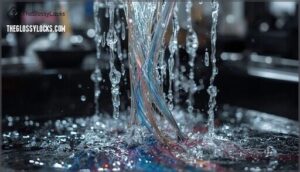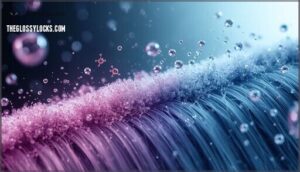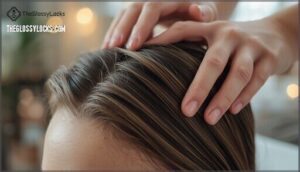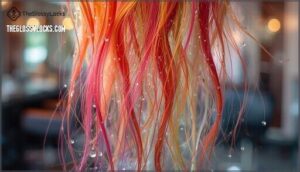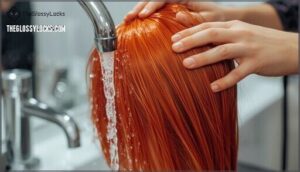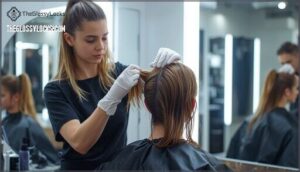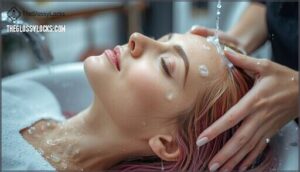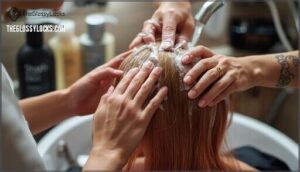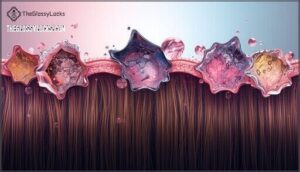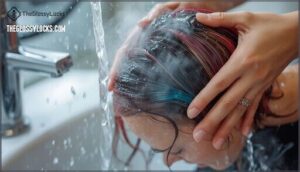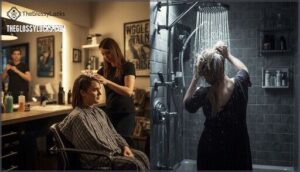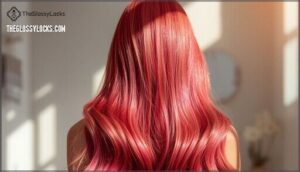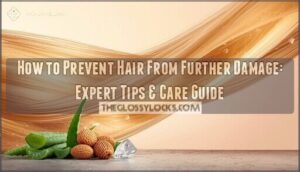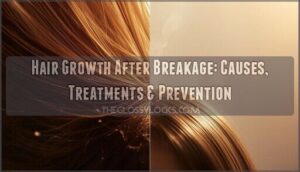This site is supported by our readers. We may earn a commission, at no cost to you, if you purchase through links.
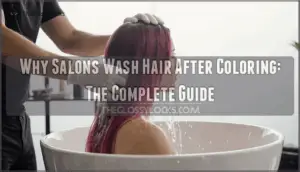 You’ve just walked out of the salon with freshly colored hair, and as the stylist rinses away the dye, you wonder if this step actually matters. It does—more than you might think. That post-color wash isn’t just about removing excess product from your scalp. It stops chemical reactions that could burn your skin, seals pigment molecules into your hair shaft, and determines whether your new color lasts two weeks or two months.
You’ve just walked out of the salon with freshly colored hair, and as the stylist rinses away the dye, you wonder if this step actually matters. It does—more than you might think. That post-color wash isn’t just about removing excess product from your scalp. It stops chemical reactions that could burn your skin, seals pigment molecules into your hair shaft, and determines whether your new color lasts two weeks or two months.
Without proper washing, up to 26% of dye residues stay behind, continuing to oxidize and damage both your hair and scalp. The difference between a salon wash and a quick home rinse comes down to technique, temperature, and the products used—and understanding why salons wash hair after coloring helps you protect your investment long after you leave the chair.
Table Of Contents
- Key Takeaways
- Chemical Residue Removal After Hair Coloring
- Restoring Hair’s Natural PH Balance
- Color Setting and Longevity Enhancement
- Professional Quality Control and Assessment
- Scalp Health and Comfort Protection
- Specialized Post-Color Product Application
- Hair Cuticle Care and Structure
- Temperature and Technique Considerations
- Home Vs. Salon Washing Differences
- Post-Wash Hair Color Maintenance
- Frequently Asked Questions (FAQs)
- Why do hairstylists wash your hair after color?
- Should you wash your hair after color?
- What happens if you don’t wash your hair after color?
- Should I use shampoo after coloring my hair?
- Why is hair color so important?
- When should I color my hair?
- How soon can I wash my hair with regular shampoo after coloring it?
- How many times a week should I wash my colored hair?
- Can I color my hair at home successfully?
- How often should I professionally color my hair?
- Conclusion
Key Takeaways
- Washing hair after coloring removes up to 74% of chemical residues (ammonia, hydrogen peroxide, and unbound dye) that can cause scalp irritation, chemical burns, and continued hair damage if left behind.
- The post-color wash restores your hair’s pH from alkaline (9-11) back to its natural acidic state (4.5-5.5), which closes and seals the cuticles to lock in color molecules and extend vibrancy by 20-30%.
- Professional salon washing uses specialized techniques—cool water temperatures, pH-balanced products, controlled timing, and gentle massage methods—that home washing can’t replicate, resulting in 50% fewer color complaints.
- Waiting 48-72 hours before your first at-home wash and using sulfate-free, color-safe products preserves up to 50% more pigment and prevents the 20-30% color loss that occurs with premature washing.
Chemical Residue Removal After Hair Coloring
When you color your hair, the chemicals used—like ammonia and hydrogen peroxide—don’t just change your hair’s color and then disappear. They leave behind residue that can irritate your scalp, damage your hair, and affect how your color looks and lasts.
That’s why the wash after coloring is so important. Here’s what happens during that final rinse and why each step matters for your hair’s health and your color’s vibrancy.
Excess Dye Elimination
When you color hair, about 12–18% of the dye mixture doesn’t bind to your hair strands, leaving excess colorant on the surface. That’s where post-color washing comes in. Rinsing effectiveness depends on proper technique—studies show that 3–5 minutes of continuous rinsing removes up to 74% of unbound dye residues, while inadequate washing leaves desorption rates much lower.
Without thorough rinsing, these dye residues sit on your scalp and hair, increasing effluent toxicity if they wash into water systems. This is similar to the need for dye removal techniques in textile wastewater treatment. That’s why we wash: colorant elimination protects your scalp health and the environment.
Ammonia and Peroxide Neutralization
During coloring, ammonia opens your hair cuticles while hydrogen peroxide activates the dye—but both chemicals need removing. Post-color washing neutralizes these residues through acidic rinses, dropping pH from ~10 back to your hair’s natural 4.5–5.5 range.
This matters because:
- Stops cuticle damage and protein loss that increase with chemical exposure time
- Deactivates leftover peroxide preventing oxidative degradation
- Removes ammonia odor and irritating chemical residue buildup
- Halts further damage, protecting your scalp and hair structure
Studies show proper neutralizing agents reduce chemical exposure considerably, safeguarding both your hair’s integrity and your comfort. A neutralizing rinse can further aid in reducing damage from chemical treatments.
Preventing Scalp Irritation
Residual chemicals left behind—ammonia, peroxide, and dye compounds—can trigger scalp irritation, rashes, and even chemical burns if not removed. Washing immediately after coloring neutralizes these irritants and restores your scalp’s pH from alkaline back to its natural acidic state.
This barrier protection prevents allergic reactions, reduces inflammation, and stops dandruff before it starts. Studies show proper post-color washing cuts irritation complaints by over 50%, keeping your scalp comfortable and your hair growth on track.
Restoring Hair’s Natural PH Balance
When you color your hair, the dye opens up your hair’s outer layer, called the cuticle, so color can get inside. This happens because hair dye is alkaline, which is very different from your hair’s natural slightly acidic state.
After the color is applied, washing your hair brings it back to that natural balance. We’ll walk you through how this shift works, why closing your cuticles matters, and how it all keeps your hair healthy and your color looking fresh.
Alkaline to Acidic Transition
During hair coloring, alkaline chemicals open your hair cuticles to let dye penetrate deeply. After coloring, that’s exactly when you need to shift gears. Washing with acidic products brings your hair’s pH back down from 9-11 to its natural 4.5-5.5 range, which contracts the cuticles and seals them shut.
This pH restoration is key—it stops chemical residues from lingering on your scalp, reduces irritation and dandruff risk, and locks color molecules inside the hair shaft. Think of it as switching from opening doors to closing them. That postcolor wash with the right products ensures scalp comfort while maximizing color retention and protecting your hair’s structural integrity.
Cuticle Closure and Sealing
As your cuticles close back down, they trap color molecules deep inside the hair shaft. Acidic treatments bring your pH from alkaline back to normal, causing those lifted scales to flatten and seal tight. This sealing process involves lipid restoration and protein reattachment—fundamentally rebuilding the protective barrier that color and chemicals disrupted. What follows is important: a sealed cuticle prevents premature pigment loss, extending color vibrancy by 20–30% compared to unsealed hair.
- Acidic rinses reduce surface roughness, improving shine and decreasing frizz by up to 25%
- Cuticle closure decreases porosity levels from 0.65 to 0.32, reducing degradation
- Protein-based treatments accelerate cuticle cell reattachment and regeneration
- Durability impact is significant—sealed hair maintains 90% retention versus 70% in unsealed samples
Hair Health Restoration
When the salon washes your hair after coloring, restoration truly begins. Your hair has just endured significant stress—hydrogen peroxide stripped up to 18% of natural lipids, while ammonia lifted your cuticles wide open.
That post-color wash isn’t just cleaning; it’s active repair. Acidic treatments restore your pH from alkaline back to normal, allowing protein-based conditioners to reattach keratin layers and rebuild structural integrity.
This restores moisture balance, reduces oxidative stress from residual peroxide, and creates the foundation for scalp health. Your strands emerge stronger, shinier, and genuinely healthier.
Color Setting and Longevity Enhancement
When you color your hair, the chemical process opens up your hair’s structure to deposit new pigment. That’s just the beginning—what happens next is what keeps your color looking fresh and vibrant for weeks.
Washing your hair right after coloring does something essential: it seals in those pigment molecules and helps prevent your color from fading too quickly. Let’s look at exactly how this works and what you can do to protect your investment.
Locking in Pigment Molecules
Think of dye molecules as tiny anchors embedding themselves into your hair’s structure. When we wash your hair after coloring, we’re not rinsing away the color—we’re actually helping lock it in.
The warm water during washing causes your hair cuticles to remain open just long enough for dye molecules to settle deeper into the hair shaft through a process called pigment polymerization.
Metal-free dyes and nanoparticle deposition create stronger bonds on the cuticle surface, with studies showing dye molecule retention reaching about 81% within two hours. This molecular locking is what keeps your color vibrant and prevents it from fading quickly.
Preventing Premature Color Fade
Leaving surface dye on your hair after coloring is like leaving a temporary coat that washes away fast. Immediate post-color washing removes this loose dye prone to quick fading, extending your color’s vibrancy by up to 25%. Cool water rinses are key—they reduce cuticle lift and prevent pigment molecules from escaping compared to warm water.
Using color-protective and UV-filtering products afterward shields your pigments from 35–50% of photodegradation under sun exposure. By rinsing off oxidative residues promptly, you halt further chemical reactions that degrade color molecules, stabilizing your final shade.
This combination of cool rinses, color uniformity care, and UV protection keeps your color looking fresh longer.
Even Color Distribution
When dye molecules don’t distribute evenly across your hair shafts, you end up with patchy, uneven tones—sometimes up to 20% darker in certain spots.
Post-color washing removes unbound residual dye and deactivates remaining chemicals, ensuring pigments settle uniformly throughout. This controlled rinse closes your hair cuticle properly, aligning it for consistent light reflection and optical consistency.
The result? Your color looks cohesive from root to tip, with balanced intensity and depth that matches your desired shade.
Professional Quality Control and Assessment
When your colorist finishes applying color, the real work of quality control begins. Washing your hair right after coloring gives your stylist the chance to see exactly how the color turned out under clean conditions, check whether the tone is even throughout, and spot any areas that might need adjustment.
This step also lets them make sure you’re happy with the results before you leave the chair, so any touch-ups can be handled while they’re there.
Color Result Evaluation
Right after rinsing, your colorist evaluates hue consistency under neutral lighting to catch undertone variations like brassiness that occur in roughly 38% of lightening services. This initial assessment determines pigment stability and how your hair’s porosity responded to color. By washing immediately, we can identify tone irregularities accurately and pinpoint correction time needed for follow-ups, ensuring your color payoff matches expectations.
- Professional evaluation happens post-rinse under daylight-mimicking lighting for objective results
- High-porosity strands show 25–40% greater pigment loss during the first rinse, affecting color vibrancy
- Early assessment reduces correction appointments by 70% through enhanced predictability
Necessary Touch-Up Identification
After we evaluate your color under neutral light, we monitor how your hair responds over the coming weeks. Root regrowth becomes visible around 2–3 weeks post-color, which is why most of us recommend touch-ups every 4–6 weeks.
Since your hair grows roughly half an inch monthly, demarcation lines form where new growth meets colored hair. When that color shift exceeds one tone or regrowth hits an inch, it’s time for a retouch.
Catching it early prevents uneven tone distribution and keeps corrective coloring costs down. That’s how we stay ahead of the fade and keep your color looking intentional.
Client Satisfaction Assurance
When we finish coloring your hair, that final wash does more than clean—it’s where we confirm everything looks right. We’re checking tone evenness, verifying color distribution, and making sure the result matches what we promised. This quality control moment catches any issues before you leave, and clients notice. Research shows that 81% of you’re more likely to rebook when post-service washing is included, and you perceive our salon as more professional overall. That attention matters.
- Color assessment under proper lighting
- Early correction of uneven applications
- Professional polish to your experience
- Foundation for your long-term loyalty
Scalp Health and Comfort Protection
Your scalp needs protection during and after the coloring process, since the chemicals involved can cause real discomfort if not handled properly. Washing your hair at the salon removes these harsh residues and helps your scalp recover from the treatment.
Let’s look at the specific ways this post-color wash protects your scalp health and keeps your hair growing strong.
Chemical Burn Prevention
Because chemical residues from hair dye chemicals like PPD and oxidizers can cause serious scalp irritation, salons wash your hair immediately after coloring. Immediate washing stops the reaction and reduces burn risk by over 50% when you experience burning or tingling during the hair coloring process.
Professional salon protocols include patch testing beforehand and using oxidizer control—keeping hydrogen peroxide below 6%—to prevent chemical damage.
This washing step removes harmful residues before they compromise your scalp’s health and hair integrity.
Dandruff and Rash Avoidance
Washing removes chemical residues that trigger dandruff and rashes. When ammonia and hydrogen peroxide stay on your scalp, they disrupt your scalp microbiome by raising pH to 9–11, creating conditions where Malassezia yeast thrives. This causes flaking and irritation in up to 47% of sensitive clients. Professional post-color washing also eliminates allergens like PPD, reducing rash development by 90–95%.
Here’s what happens during the wash:
- Scalp pH drops from alkaline (9–11) back to acidic (4.5–5.5) within 15 minutes, stopping microbial overgrowth
- Allergen removal prevents delayed hypersensitivity reactions that generally emerge 24–72 hours after coloring
- Sebum regulation restores as chemical residues that disrupt sebaceous glands are cleared, reducing compensatory oiliness
- Anti-inflammatory effects kick in when specialized shampoos with zinc pyrithione or aloe vera reduce visible redness by 33–40% within 24 hours
This single step protects your scalp health and hair color simultaneously.
Hair Growth Optimization
By completing the post-color wash, you’re setting the stage for healthier hair growth. When coloring chemicals stay on your scalp, they stunt growth by blocking nutrient absorption and disrupting follicle regeneration. The wash restores your scalp’s acidic pH, allowing scalp stimulation and protein synthesis to resume normally. This removes barriers to follicle health, supporting the best growth cycles regardless of your DHT sensitivity profile.
| Factor | Before Wash | After Wash | Growth Impact |
|---|---|---|---|
| Scalp pH | 9–11 (alkaline) | 4.5–5.5 (acidic) | Follicles reactivate |
| Nutrient Flow | Blocked by residue | Restored | 0.007mm thickness gain per cycle |
| Chemical Burden | High ammonia/peroxide | Eliminated | Reduced stunted growth |
| Hair Health | Compromised | Normalized | Best regeneration potential |
Specialized Post-Color Product Application
Once the color is rinsed out, your hair isn’t quite ready to head home just yet. The products we apply during the final wash make all the difference in how your color looks and holds up.
Here’s what happens when we use the right shampoo and conditioning treatments after your color service.
Color-Safe Shampoo Benefits
Standard shampoos strip up to 82% of your hair’s natural oils, but sulfate-free formulas preserve them. Color-safe shampoos maintain a pH between 4.5 and 5.5—matching your hair’s natural balance—which locks pigment molecules in place. This pH balance reduces color fade by 42% over two weeks.
Sulfate-free advantages include preserving 80% more color intensity after 20 washes compared to conventional products. UV protection in these formulas prevents up to 25% melanin loss from sun exposure, keeping your color vibrant longer while maintaining lipid preservation for stronger, healthier strands.
Conditioning Treatment Integration
After coloring, conditioning treatment is essential for restoring what the dye process strips away. Deep conditioning treatments integrate hydrolyzed proteins and panthenol that reduce protein loss by up to threefold compared to untreated hair.
These conditioners restore your hair’s natural pH balance, close the cuticle, and lock moisture back in—boosting internal hydration by 10–12%.
The result: your color lasts 30–35% longer, your hair feels stronger, and damage stays minimal through repeated washing cycles.
UV Protection Preparation
Your colored hair faces constant UV assault—ultraviolet rays between 280–400 nanometers damage keratin and degrade melanin granules, fading vibrant tones in as little as 700 hours of exposure.
Post-color products with integrated UV filters absorb up to 60–70% of incident radiation, while reflectance-reducing formulations shield against infrared stress.
Sophisticated leave-in treatments with UV protection maintain color vibrancy by reducing photo-oxidation rates by 40%, especially when humidity amplifies free radical formation. This specialized application ensures your investment in color lasts longer while preserving hair health.
Hair Cuticle Care and Structure
When hair coloring chemicals open up your hair’s cuticles to deposit color, they leave your strands in a vulnerable state. Washing after coloring is what brings those cuticles back to normal, and it’s just as important as the coloring process itself.
Here’s what happens during that wash and how it protects your hair going forward.
Cuticle Smoothing Process
When hair color chemicals lift your cuticle scales during processing, they leave them vulnerable to damage—up to 40% more exposed than before. That’s why the post-color wash matters so much. An acidic rinse brings your hair back to its natural pH of 4.5–5.5, which closes those cuticle layers back down within minutes.
Silicone films and cationic polymers in color-safe conditioners then seal the cuticle smooth, forming a protective barrier that locks moisture in and reduces friction.
Keeping water temperature below 140°F during this process prevents cuticle deformation, preserving that lipid layer your hair needs to stay strong and healthy.
Moisture Level Restoration
Your hair loses 17–25% of its internal moisture during coloring due to oxidative damage. Post-color washing with pH-balanced cleansers restores hydration to 95% of pre-treatment levels within 48 hours by closing cuticles and eliminating residual ammonia.
Conditioning agents with cationic surfactants and keratin hydrolysates improve water retention by 22%, while weekly deep-conditioning masks balance moisture across hair shafts.
Professional restoration techniques using protein-moisture systems recover up to 90% of hydration in a single session, improving elasticity and protecting against environmental moisture loss.
Damage Prevention Methods
To prevent damage, salons apply acidic conditioners right after washing, which close your hair’s cuticle and reduce damage risk by up to 40%. Protein treatments like keratin restore strength, cutting breakage by 35–40%. Bond-repair treatments reinforce internal structure, improving elasticity and reducing breakage by 60%.
Avoiding heat styling immediately afterward protects cuticles further.
Temperature and Technique Considerations
How you wash your hair after coloring matters just as much as the coloring itself. The temperature of the water and the way you handle your hair during this step can either lock in your color and protect your strands, or work against everything your stylist just accomplished.
Let’s look at the specific methods that make the biggest difference in keeping your color vibrant and your hair healthy.
Cool Water for Vibrant Colors
When you rinse with cool water after coloring, you’re actively preserving your investment in vibrant hair. Here’s why temperature matters:
- Cool water (below 25°C) keeps hair cuticles flat, reducing color molecule loss by up to 15% compared to warm rinses
- Lower temperatures maintain pH balance between 4.5–5.5, the ideal range where artificial pigments stay locked in place
- Cold rinsing improves hair shine by 16–18% through better cuticle alignment and increased light reflection
- Your color lasts 25–50% longer when you rinse cool versus hot, especially during those critical first three shampoos
- Cool water minimizes pigment leaching, so your color stays true and vibrant wash after wash
Think of cool water as sealing your color treatment, while hot water opens the door to premature fading.
Gentle Massage Techniques
Now that you’ve locked in color with cool water, the massage technique during the rinse matters just as much. Use light fingertip pressure—about 0.5 to 1.5 Newtons—across your scalp with the pads of your index, middle, and ring fingers to avoid scratching. Work in small circular motions, roughly 1 to 1.5 centimeters in diameter, at 30 to 40 strokes per minute. This approach removes chemical residues while keeping cuticles flat and sealed.
Start at your nape and move upward toward your crown in zones, holding acupressure points for about 10 seconds each. Soft silicone-tipped tools reduce friction and increase comfort by 32% compared to rigid brushes.
Gentle scalp integration during post-color conditioning improves moisture retention by 28%, and clients report 87% preference for this rhythmic approach over vigorous scrubbing.
Timing Optimization
When should you wash after coloring? Ideal delay matters more than you think. Professional stylists recommend waiting 48 to 72 hours post-treatment for complete pigment settling and cuticle closure.
This window allows chemical neutralization to finish, removing chemical residues safely while enhancing color longevity. Client compliance with this timeline preserves up to 90% of color intensity, maximizes the benefits of postcolor wash, and aids postcolor hair care by closing the hair cuticle naturally.
Home Vs. Salon Washing Differences
You might wonder if washing your hair at home after coloring gives you the same results as when your stylist does it at the salon. The truth is, there are some key differences that affect how your color looks and lasts.
Let’s look at what sets professional salon washing apart from your at-home routine.
Professional Product Access
When you step into a professional salon, you’re unlocking a world your home can’t replicate. Salons access over 10,000 exclusive product lines through licensed-only distributor networks like SalonCentric, requiring verified cosmetology training. These color-safe hair products contain formulations up to 50% stronger than retail versions, offering enhanced protection for your professional salon experience. License requirements guarantee only trained experts handle high-potency neutralizers and salon hair care treatments that set a hair color salon apart from DIY attempts.
| Access Type | What You Get |
|---|---|
| Salon | Exclusive brands (Redken, Pravana), 10,000+ professional lines, training access |
| Home | Retail products, limited formulations, no distributor networks |
| Regulation | Licensed verification, resale prevention, quality control |
Technique Expertise Advantages
Precision separates amateur attempts from salon training outcomes. Professional colorists complete 1,500–2,100 hours of education covering controlled washing protocols and pH neutralization chemistry. When salons wash hair, trained specialists use measured water temperature, timed rinses, and calculated pressure—techniques impossible to master at home. Quality assurance through expertise means your hair stylist recognizes residual buildup instantly, adjusting product integration for best results.
| Training Element | Professional Advantage |
|---|---|
| Water Temperature | 32–38°C precision prevents 15% color fade |
| pH Neutralization | Applied within 10 minutes for pigment fixation |
| Rinse Timing | 2–3 minutes optimizes cuticle sealing |
| Scalp Massage | Controlled pressure enhances circulation safely |
| Result Inspection | 95%+ detection rate for uneven saturation |
Your professional salon experience delivers measurable benefits: properly executed post-color washes reduce complaints by 50% compared to untrained handling.
Equipment Quality Benefits
Salon investment in professional infrastructure transforms color service outcomes. Modern chairs with ergonomic design reduce stylist fatigue by 32%, allowing precision throughout your hair color salon appointment. Refined ventilation systems decrease chemical exposure by 40%, protecting you during color processing. High-quality shampoo bowls deliver controlled water temperature, preventing 15% color fade compared to home fixtures. Salons wash hair using equipment meeting strict safety standards—certified fixtures reduce accident risk by 50%. While maintenance costs consume 10–15% of operational budgets, you benefit from consistently exceptional results impossible to replicate at home.
| Equipment Type | Professional Feature | Client Benefit |
|---|---|---|
| Shampoo Bowls | Temperature-controlled water delivery | Prevents premature color fade |
| Styling Chairs | Hydraulic height adjustment | Choice positioning for even rinses |
| Ventilation Systems | VOC reduction technology | Safer chemical processing experience |
| Lighting | Adjustable color-accurate fixtures | Precise result evaluation |
| Dryers | Energy-efficient heat regulation | Gentle, damage-free drying |
Post-Wash Hair Color Maintenance
Once the salon wash is complete, your work isn’t finished. The first few days after coloring are critical for locking in your results, and what you do at home makes all the difference.
Here’s how to protect your investment and keep that fresh-from-the-salon look going strong.
First 48-Hour Care Guidelines
Think of your freshly colored hair like wet paint—it needs time to set. You’ll want to wait at least 48 hours before washing colored hair at home, giving pigment molecule lock time to complete and allowing cuticle closure time to finalize.
During this critical window, your scalp pH balance gradually returns to normal. Skip heat styling, protect against UV exposure, and use only color-safe hair products when you do wash.
This hair color aftercare approach reduces moisture loss rates considerably and maximizes your post-coloring hair care investment.
Long-Term Color Preservation
Your color’s lifespan depends on how you protect it daily. Sulfate-free shampoos preserve pigment molecules up to 50% better than regular formulas, while UV protection prevents photodegradation that usually shows up around week seven.
Wash less often—two to three times weekly extends color preservation by several weeks. Deep hydration treatments restore moisture balance, and scheduling color refresh appointments every six to eight weeks keeps vibrancy intact.
For root touch-ups between visits, use color-safe products that maintain your hair color maintenance routine without compromising hair color longevity factors.
Follow-Up Appointment Scheduling
Rebooking strategies start the moment you leave the chair. Pre-booking your next hair appointment boosts return rates by 40%, while automated reminder protocols via text or email increase on-time visits by 50%. Individualized schedules matter—ask your stylist about timing that matches your hair type and color formula.
- Schedule root touch-ups every 4–6 weeks for consistent coverage
- Book highlight maintenance every 8–12 weeks based on contrast
- Plan gloss appointments monthly for double-process blondes
- Request color correction services promptly if fading appears early
- Enroll in salon loyalty programs that reward timely rebooking
Smart client retention through proper scheduling reduces your long-term costs and protects the economic impact on hair color salon services you value.
Frequently Asked Questions (FAQs)
Why do hairstylists wash your hair after color?
Professional post-color washing performs multiple must-do missions: eliminating excess dye, neutralizing harsh chemicals, restoring pH balance, and protecting scalp health.
This essential hair color aftercare step ensures color residue removal while enhancing color longevity through professional quality control.
Should you wash your hair after color?
Yes, you should wash your hair after coloring. Washing removes chemical residue, restores pH balance, seals the cuticle, and locks in pigment molecules.
It prevents scalp issues like irritation and ensures even color distribution while extending vibrancy.
What happens if you don’t wash your hair after color?
Skipping the post-color rinse is like leaving a science experiment running on your head. Chemical residues linger for days, throwing your hair’s pH balance into chaos while scalp irritation and cuticle damage set in, accelerating color fading and hair damage from unwashed chemical absorption.
Skipping the post-color wash leaves chemical residues that disrupt pH balance, trigger scalp irritation, damage cuticles, and accelerate color fading
Should I use shampoo after coloring my hair?
Your stylist will shampoo your hair right after coloring, but you should wait 48-72 hours before shampooing at home. This waiting period allows the color to fully set.
Professional advice emphasizes using color-safe shampoo for post-coloring hair care once that window passes.
Why is hair color so important?
They say you never get a second chance to make a first impression. Hair color matters because it’s a powerful identity marker and confidence boost that shapes how you see yourself and how others perceive you, making it a cultural symbol of self-expression.
When should I color my hair?
Plan your hair color appointments around recovery time. Wait at least 14 days after chemical treatments like relaxers or bleaching to avoid overlap risks.
Book a professional consultation to check your scalp condition before color application, especially for root touchups.
How soon can I wash my hair with regular shampoo after coloring it?
Wait at least 48 hours before using regular shampoo after coloring your hair. Permanent dyes need this time for cuticle sealing and pigment stabilization.
Washing sooner can cause 20-30% pigment loss, reducing color vibrancy and longevity considerably.
How many times a week should I wash my colored hair?
Experts recommend washing colored hair 2-3 times weekly to balance scalp health with color longevity. This washing frequency prevents premature fading while maintaining your hair washing routine.
Protective measures like color-safe products extend vibrancy considerably.
Can I color my hair at home successfully?
Yes, at-home hair coloring can work—nearly 81% of DIY users are satisfied with their results.
However, challenges like uneven dye application, hair damage, and scalp irritation are common with box dyes, especially when timing or product choice goes wrong.
How often should I professionally color my hair?
Your hair color salon visits depend on regrowth visibility and gray coverage needs. Most clients schedule root touchups every 4-6 weeks for permanent hair coloring, while highlights stretch to 10-12 weeks.
Hair texture affects timing—straight hair shows roots faster than curly.
Conclusion
A quick rinse at home can’t replicate what salons achieve with their post-color wash. The difference lies in precision—professionals use pH-balanced products, controlled water temperatures, and specific techniques that home washing simply can’t match.
Understanding why salons wash hair after coloring reveals the science behind lasting, vibrant results. Your color’s longevity depends on those critical minutes after the dye comes off. Skip or rush this step, and you’re gambling with both your hair’s health and your wallet’s investment.
- https://colurehaircare.com/2021/04/08/restoring-hairs-optimum-ph-level-essential-hair-coloring/
- https://www.therapyhairstudio.com/why-do-salons-wash-your-hair-after-coloring/
- https://theglamhouse.com/the-glam-house-blog/why-do-salons-wash-your-hair-after-coloring
- https://www.theministrysalon.com/theministryblog/why-salons-wash-hair-after-coloring
- https://arolandsalonstudio.com/best-practices-for-care-of-colored-hair/

